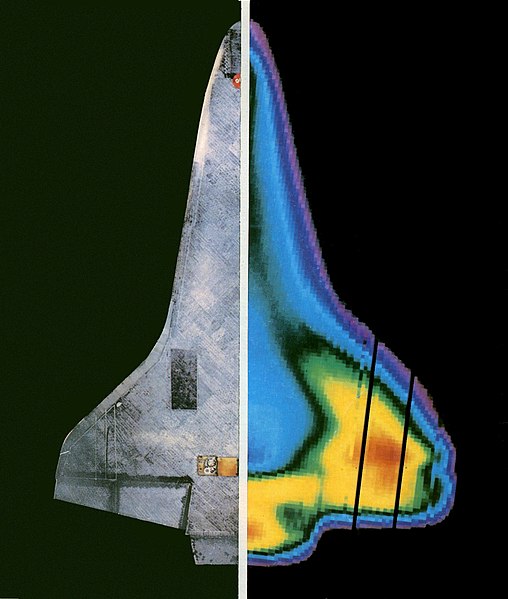|
تضامنًا مع حق الشعب الفلسطيني |
ملف:STS-3 infrared on reentry.jpg

الملف الأصلي (1٬486 × 1٬752 بكسل حجم الملف: 489 كيلوبايت، نوع MIME: image/jpeg)
| هذا ملف من ويكيميديا كومنز. معلومات من صفحة وصفه مبينة في الأسفل. كومنز مستودع ملفات ميديا ذو رخصة حرة. |
ملخص
| الوصفSTS-3 infrared on reentry.jpg |
English: Infrared Camera "Takes Shuttle's Temperature"
As the Shuttle Orbiter Columbia returned to Earth, March 30, 1982, an airborne infrared telescope made this image of its heating patterns. The "heat picture" (right half) was taken aboard NASA's Kuiper Airborne Observatory, a Lockheed C-141 Starlifter aircraft specially equipped with a 91.5-cm (36-in.) aperture Cassegrain-type reflector telescope. The Kuiper Observatory aircraft made the image as Columbia raced overhead at a height of 56 kilometers (185,000 feet) at a speed of Mach 15.6. For comparison purposes the heat image of the returning Shuttle Orbiter is shown at the right in the illustration, with a picture of the bottom surface of the spacecraft shown as the other half (left). Nose and main landing gear doors are plainly visible on the left side, as are the leading edge thermal protection surfaces and the elevon hinge area. The dots enclosed by white circles (near the nose and just right of the elevon hinge toward the center line) are the umbilical connectors for mounting the Orbiter on the Boeing 747 ferry aircraft. The vertical black lines toward the outside of the wing/elevon on the heat image side (right) were caused by two inoperative sensor channels. Sensors incorporated in the experiment, called the Infrared Imagery of Shuttle (IRIS), collected readings resulting in this computer-generated image of Columbia's underside. Hottest areas appear red and the least hot areas violet. Thus, these colors in the heat image represent the temperature gradation:
The Shuttle Orbiter was designed to withstand temperatures of 1650 degrees C (3000 degrees F.) on its reinforced carbon/carbon leading edge surfaces and 1315 degrees C (2400 degrees F.) on its most heat-resistant tiles. Highest temperatures on re-entry for the third Shuttle test mission reached 1544 degrees C (2840 degrees F.) on reinforced carbon/carbon surfaces in the nose area. Assignment of temperature values or ranges to each of the colors awaits careful study and adjustment of the IRIS image. Because Columbia and the observatory airplane were not directly above and below each other when the heat image was made, data must be corrected and adjusted with computer assistance. The final image should appear as it would if the line-of-sight axis of the telescope were at right angles to the under surface of Columbia.The re-entering spacecraft showed a 41.5-degree angle of attack and a 59-degree roll angle. Scientists and engineers refer to this procedure as "orthogonalizing" the data. Heat data derived from the adjusted infrared image will be compared with simultaneous readings from seven thermal sensors on the underside of the Orbiter. Kuiper Observatory's heat image was made approximately 150 miles south of Los Angeles, late in the 129th orbit of the third Shuttle test mission. At the time, Columbia was 16.5 minutes into atmosphere re-entry and approaching the coast of Mexico's Southern California Peninsula. Kuiper Airborne Observatory is based and operated by NASA's Ames Research Center, Mountain View, California. The IRIS experiment is funded by NASA's Office of Aeronautics and Space Technology, Washington, D.C. IRIS data are expected to assist in continued development of improved thermal protection materials, an effort for which Ames Center has major responsibility. Classroom Discussion
Final Report Infrared Imagery of Shuttle (IRIS) experment: IRIS/STS-3 engineering report. NASA Ames Research Center, Project Technology Branch (SPT). June 23, 1982. |
| التاريخ | 09:18-08:00 |
| المصدر | NASA handout HqL-117 |
| المؤلف | NASA |
| إصدارات أخرى |
|
| موقع آلة التصوير | ٣٠° ٤١′ ٥٤″ ش, ١١٨° ١٤′ ٤٢″ ب | هذه وغيرها من الصور في مواقعها على: خريطة الشارع المفتوحة |
|---|
| موقع الكائن | ٣٠° ٥٦′ ٥٤″ ش, ١١٨° ٢٢′ ١٨″ ب | هذه وغيرها من الصور في مواقعها على: خريطة الشارع المفتوحة |
|---|
See also
- Thomas Horvath et al. Shuttle Entry Imaging Using Infrared Thermography 39th AIAA Thermophysics Conference AIAA 2007-4267
25-28 June 2007. Miami, FL.
ترخيص
| Public domainPublic domainfalsefalse |
| يقع هذا العمل في النِّطاق العامّ في الولايات المُتحدة الأمريكيَّة لأَنَّه عملٌ خالِصٌ من إِنتاج وكالة الفضاء الأمريكيَّة. تنصُ حقوق التَّأليف والنَّشر الخاصَّة بوكالة الفضاء الأمريكيَّة على أنَّ "أعمال الوكالة غير مَحميَّة بحقوق التَّأليف والنَّشر ما لم يُذكر خلافُ ذلك". لمزيدٍ من المعلومات انظر القالِب {{PD-USGov}} وصفحة حقوق التَّأليف والنَّشر الخاصَّة بالوكالة وصفحة سياسة الصُّور الخاصَّة بمُختبر الدَّفع النَّفَّاث. |  | |
 |
تنبيهات:
|
الشروحات
العناصر المصورة في هذا الملف
يُصوِّر
٣٠ مارس 1982
30°41'53.999"N, 118°14'42.000"W
coordinates of depicted place الإنجليزية
30°56'53.999"N, 118°22'18.001"W
تاريخ الملف
اضغط على زمن/تاريخ لرؤية الملف كما بدا في هذا الزمن.
| زمن/تاريخ | صورة مصغرة | الأبعاد | مستخدم | تعليق | |
|---|---|---|---|---|---|
| حالي | 08:21، 18 مايو 2013 |  | 1٬486 × 1٬752 (489 كيلوبايت) | commonswiki>Ke4roh | add some noise in the black sky on the visible image side so it looks more like the original and not so weird |
استخدام الملف
ال1 ملف التالي مكررات لهذا الملف (المزيد من التفاصيل):
- ملف:STS-3 infrared on reentry.jpg من ويكيميديا كومنز
الصفحة التالية تستخدم هذا الملف:
